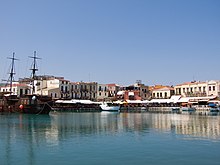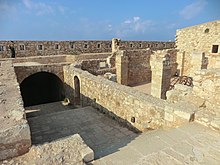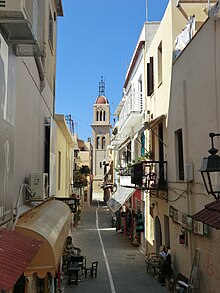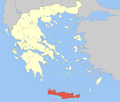Rethymno
Rethymno
Ρέθυμνο | |
|---|---|
Settlement | |
 View of Rethymno | |
| Coordinates: 35°22′N 24°28′E / 35.367°N 24.467°E | |
| Country | Greece |
| Administrative region | Crete |
| Regional unit | Rethymno |
| Municipality | Rethymno |
| Government | |
| • Mayor | Giorgos Marinakis (PASOK) |
| Area | |
| • Municipal unit | 126.5 km2 (48.8 sq mi) |
| • Community | 26.777 km2 (10.339 sq mi) |
| Highest elevation | 15 m (49 ft) |
| Lowest elevation | 0 m (0 ft) |
| Population (2011)[1] | |
| • Municipal unit | 37,462 |
| • Municipal unit density | 300/km2 (770/sq mi) |
| • Community | 34,300 |
| • Community density | 1,300/km2 (3,300/sq mi) |
| Time zone | UTC+2 (EET) |
| • Summer (DST) | UTC+3 (EEST) |
| Postal code | 741 00 |
| Area code(s) | 28310 |
| Vehicle registration | ΡΕ |
| Website | www.rethymno.gr |
Rethymno (Template:Lang-el, [ˈreθimno], also Rethimno, Rethymnon, Réthymnon, and Rhíthymnos) is a city of approximately 40,000 people in Greece, the capital of Rethymno regional unit on the island of Crete, a former Latin Catholic bishopric as Retimo(–Ario) and former Latin titular see.
Rethymno was originally built during the Minoan civilization (ancient Rhithymna and Arsinoe). The city was prominent enough to mint its own coins and maintain urban growth. One of these coins is today depicted as the crest of the town: two dolphins in a circle.
History

This region as a whole is rich with ancient history, most notably through the Minoan civilisation centred at Kydonia east of Rethymno.[2] Rethymno itself began a period of growth when the Venetian conquerors of the island decided to put an intermediate commercial station between Heraklion and Chania, acquiring its own bishop and nobility in the process. Today's old town (palia poli) is almost entirely built by the Republic of Venice. It is one of the best-preserved old towns in Crete.
From circa 1250 the city was the see of the Latin Diocese of Retimo, which was renamed Retimo–Ario after the absorption in 1551 of the Diocese of Ario and as suppressed only after the Turkish conquest.
The town still maintains its old aristocratic appearance, with its buildings dating from the 16th century, arched doorways, stone staircases, Byzantine and Hellenic-Roman remains, the small Venetian harbour and narrow streets. The Venetian Loggia houses the information office of the Ministry of Culture and Sports. A Wine Festival is held there annually at the beginning of July. Another festival, in memory of the destruction of the Arkadi Monastery, is held on 7–8 November.

The city's Venetian-era citadel, the Fortezza of Rethymno, is one of the best-preserved castles in Crete. Other monuments include the Neratze mosque (the Municipal Odeon arts centre), the Great Gate (Μεγάλη Πόρτα or "Porta Guora"), the Piazza Rimondi and the Loggia.
The town was captured by the Ottoman Empire in 1646 during the Cretan War (1645–69) and they ruled it for almost three centuries. The town, called Resmo in Turkish, was the centre of a sanjak (administrative part of a province) during Ottoman rule.
During the Battle of Crete (20–30 May 1941), the Battle of Rethymno was fought between German paratroopers and the Second Australian Imperial Force and Hellenic Army. Although initially unsuccessful, the Germans won the battle after receiving reinforcements from Maleme in the Northwestern part of the island
Today the city's main income is from tourism, many new facilities having been built in the past 20 years. Agriculture is also notable, especially for olive oil and other Mediterranean products.
Municipality

The municipality Rethymno was formed at the 2011 local government reform by the merger of the following 4 former municipalities, that became municipal units:[3]
- Arkadi
- Lappa
- Nikiforos Fokas
- Rethymno
- Population of Rethymno [4]
| Settlements | 1940 | 1951 | 1961 | 1971 | 1981 | 1991 | 2001 | 2001 |
|---|---|---|---|---|---|---|---|---|
| Rethymno | 8,648 | 11,057 | 14,999 | 14,969 | 17,136 | 23,355 | 28,987 | 32,468 |
| Agia Eirini | 96 | 88 | 63 | 47 | 34 | 63 | 49 | 75 |
| Agios Markos | - | - | - | - | 18 | 65 | - | - |
| Anogeia | 50 | 25 | 25 | 21 | 13 | 15 | 89 | 131 |
| Gallos | 315 | 274 | 252 | 180 | 146 | 205 | 430 | 922 |
| Giannoudi | 92 | 82 | 78 | 30 | 22 | 23 | 96 | 116 |
| Kastellakia | - | 45 | 27 | 36 | 105 | - | - | - |
| Koumpes | - | 106 | - | - | - | - | - | - |
| Metochi Albani | 67 | 79 | 31 | - | - | - | - | - |
| Megalo Metochi (Risvan) | - | 33 | 25 | - | 6 | 28 | 29 | 46 |
| Mikro Metochi | - | - | - | - | 29 | 91 | 188 | 149 |
| Misiria | 294 | 212 | - | - | - | - | - | - |
| Xiro Chorio | 214 | 219 | 132 | 90 | - | 114 | 131 | 221 |
| Perivolia | 853 | 805 | - | - | - | - | - | - |
| Planates | 343 | 488 | - | - | - | - | - | - |
| Tria Monastiria | - | - | - | - | 18 | 105 | 107 | 172 |
| Total | 10,972 | 13,513 | 15,632 | 15,373 | 18,190 | 24,064 | 31,687 | 34,300 |
Culture

Rethymno is home to the following museums:
- Archaeological Museum of Rethymno
- Historical and Folklore Museum of Rethymno
- Municipal Gallery "L. Kanakakis"
- The Frantzeskaki Collection
- Museum of Sea Life at Rethymno
Literature
Pandelis Prevelakis wrote Το χρονικό μιας πολιτείας (1937), The Chronicle of my Town, a nostalgic depiction of Rethymno from the period of the Cretan State (1898) to the expulsion of the Cretan Turks (1924).
Sports

Rethymno hosted the international athletics meeting known as Vardinogianneia. The athletics meeting stopped in 2012 due to Greek financial crisis.[5] Rethymno has many sport clubs with presence in Panhellenic championships of various sports. Below is shown the list of main sport clubs of Rethymno.
| Sport clubs based in Rethymno | |||
|---|---|---|---|
| Club | Founded | Sports | Achievements |
| Neos Asteras Rethymno F.C. | 1945 | Football | Earlier presence in Gamma Ethniki |
| NO Rethymnou | 1963 | Water Polo | Presence in A1 Ethniki women |
| EA Rethymniakou | 1983 | Football, Track and Field | Earlier presence in Beta Ethniki |
| Rethymno B.C. | 1986 | Basketball | Presence in A1 Ethniki |
| OPE Rethymnou | 1992 | Volleyball | Presence in A1 Ethniki women |
Education

In the Rethymno Campus of the University of Crete there are located the School of Philosophy, the School of Education, the School of Social, Economics and Political Sciences, and the University Library of the University of Crete. More, there are about 8.000 students per annum studying at "Galos" where the Campus (and also the Academic Institute of Mediterranean Studies) rests. Also in Rethymnon is located the Department of Music Technology and Acoustics Engineering of the School for Applied Sciences of the Technological Institute of Crete (TEI of Crete) with ~500 Students. Finally in Rethymno is located the international research Centre for Plasma Physics and Laser of the TEI of Crete.
Geography
Climate
| Climate data for Rethymno, Greece | |||||||||||||
|---|---|---|---|---|---|---|---|---|---|---|---|---|---|
| Month | Jan | Feb | Mar | Apr | May | Jun | Jul | Aug | Sep | Oct | Nov | Dec | Year |
| Mean daily maximum °F (°C) | 55 (13) |
55 (13) |
59 (15) |
64 (18) |
73 (23) |
82 (28) |
86 (30) |
86 (30) |
81 (27) |
72 (22) |
64 (18) |
57 (14) |
69.5 (20.8) |
| Mean daily minimum °F (°C) | 45 (7) |
45 (7) |
46 (8) |
52 (11) |
57 (14) |
64 (18) |
70 (21) |
70 (21) |
64 (18) |
59 (15) |
54 (12) |
48 (9) |
56.166 (13.43) |
Source: <Holiday Weather >Rethymnon: Annual Weather Averages. Holiday Weather. 2016 http://www.holiday-weather.com/rethymnon/averages/. Retrieved 12 September 2016. {{cite web}}: Missing or empty |title= (help)
| |||||||||||||
Notable locals
- Royalty and politics
- Georgios Chortatzis (1545–1610), dramatist in Cretan verse
- Ahmed Resmî Efendi (1700–1783), Ottoman statesman, author and ambassador
- Nikolaos Sifounakis (born 1949), Greek politician
- Emetullah Rabia Gülnuş Sultan (1642–1715), valide sultan
- Other
- Marcus Musurus (1470–1517), scholar and philosopher
- Pandelis Prevelakis (1909–1986), writer
- Manolis Xexakis (born 1949), poet and writer
- Nick Dandolos (1883–1966), professional poker player
International relations
Rethymno is twinned with :
Gallery
-
Panorama of the town
-
Rimondi Fountain
-
Venetian loggia
-
Guora Gate (Megali Pyli), old city gate
-
View of the old town
-
Sultan Ibrahim mosque
-
The catholic church of Agios Antonios
-
Eleftherios Venizelos statue
See also
References
- Notes
- ^ "Απογραφή Πληθυσμού - Κατοικιών 2011. ΜΟΝΙΜΟΣ Πληθυσμός" (in Greek). Hellenic Statistical Authority.
- ^ C. Michael Hogan, Cydonia, The Modern Antiquarian, Jan. 23, 2008
- ^ Kallikratis law Greece Ministry of Interior Template:El icon
- ^ Hellenic Statistical Authority, Digital Library (ELSAT), Census (Greek and English)
- ^ "Χωρίς «Βαρδινογιάννεια» και το 2013". rethnea.gr. Retrieved 11 November 2015.
External links
 Rethymno travel guide from Wikivoyage
Rethymno travel guide from Wikivoyage
http://www.explorerrethymno.gr
- Prefecture of Rethymno - Official website
- Rethymno The Official website of the Greek National Tourism Organisation











